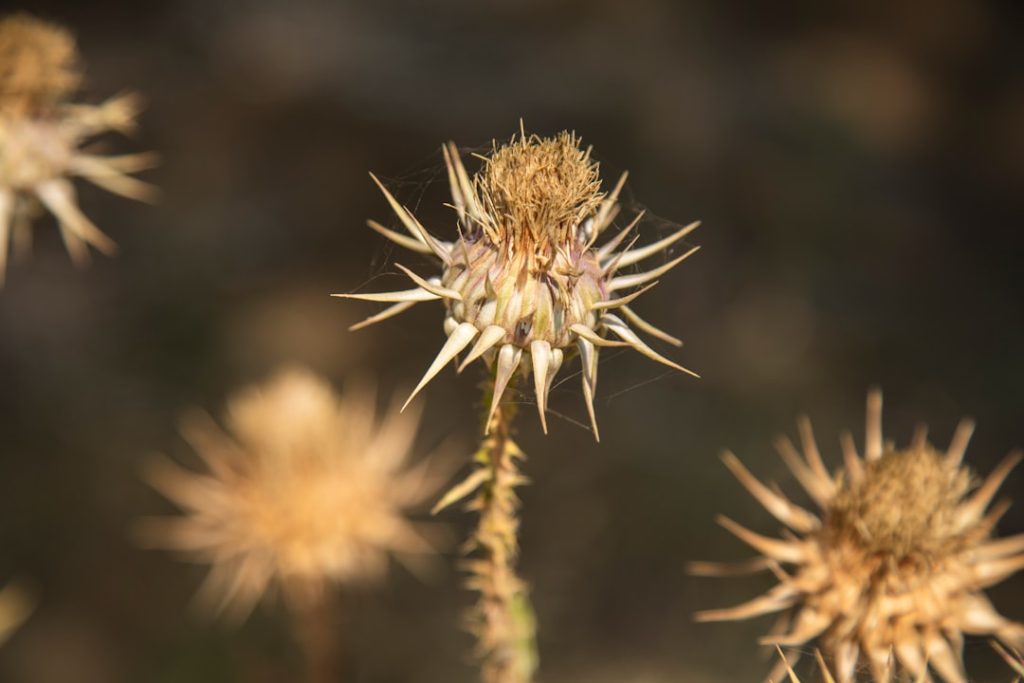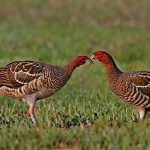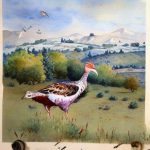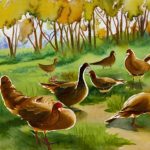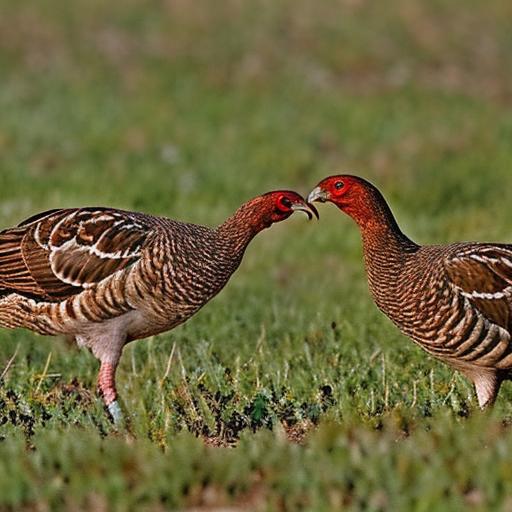Wild turkeys are large, ground-dwelling birds native to North America. They are known for their striking plumage and impressive courtship displays during the breeding season. There are six subspecies of wild turkeys, each with its own unique characteristics and range. These birds are highly adaptable and can be found in a variety of habitats, including forests, grasslands, and swamps.
Wild turkeys play an important role in the ecosystem as seed dispersers and insect predators. They are also a popular game bird, attracting hunters from all over the country. However, due to habitat loss and overhunting, wild turkey populations declined significantly in the past. Thanks to conservation efforts and reintroduction programs, their numbers have rebounded in many areas, making them a conservation success story.
Table of Contents
- 1 Factors influencing Breeding Season
- 2 Timing of Breeding Season
- 3 Courtship and Mating Behavior
- 4 Nesting and Egg-laying
- 5 Hatching and Rearing of Chicks
- 6 Conclusion and Conservation Efforts
- 7 FAQs
- 7.1 What is the breeding season for wild turkeys?
- 7.2 Why do wild turkeys breed in the spring?
- 7.3 How do wild turkeys attract mates during breeding season?
- 7.4 How many eggs do wild turkeys typically lay during breeding season?
- 7.5 How long is the incubation period for wild turkey eggs?
- 7.6 When do wild turkey poults hatch after the breeding season?
Key Takeaways
- Wild turkeys are large birds native to North America and are known for their distinctive fan-shaped tails and wattled necks.
- Factors influencing the breeding season of wild turkeys include photoperiod, temperature, and food availability.
- The breeding season for wild turkeys typically occurs in the spring, with peak mating activity in April and May.
- Courtship and mating behavior of wild turkeys involve elaborate displays and vocalizations by males to attract females.
- Nesting and egg-laying for wild turkeys usually take place in well-hidden ground nests, with females laying around 10-12 eggs over a period of 10-14 days.
Factors influencing Breeding Season
The breeding season, also known as the mating season, is a crucial time for wild turkeys. Several factors influence the timing and success of breeding, including environmental conditions, food availability, and social dynamics within the turkey population. As the days grow longer and temperatures rise in the spring, wild turkeys become more active and begin to display courtship behaviors.
Food availability is a key factor in determining the success of the breeding season. Wild turkeys rely on a diverse diet of seeds, fruits, insects, and small vertebrates. A plentiful supply of food ensures that turkeys are in good physical condition, which is essential for successful reproduction. Additionally, the availability of suitable nesting sites and cover for brooding hens is crucial for the survival of turkey chicks.
Timing of Breeding Season
The timing of the breeding season varies depending on the geographic location and local environmental conditions. In general, wild turkeys breed in the spring, with the peak of mating activity occurring in April and May. This timing coincides with the availability of abundant food resources and favorable weather conditions for nesting and rearing young.
In northern regions, where winters are harsh and food is scarce, wild turkeys may delay breeding until later in the spring. In contrast, in southern regions with milder climates, turkeys may begin breeding as early as February. The timing of the breeding season is also influenced by the age and reproductive status of individual turkeys. Older, more experienced birds tend to breed earlier in the season, while younger birds may delay breeding until they are in better physical condition.
Courtship and Mating Behavior
During the breeding season, male wild turkeys, known as toms, engage in elaborate courtship displays to attract females, or hens. These displays involve puffing up their feathers, fanning their tails, and strutting around while making low-pitched drumming sounds. Toms also engage in aggressive behaviors, such as sparring with other males, to establish dominance and access to females.
Once a tom has attracted the attention of a hen, he will continue to display and vocalize to court her. If the hen is receptive, she will crouch down and allow the tom to mount her for mating. After mating, the hen will begin searching for a suitable nesting site to lay her eggs.
Nesting and Egg-laying
After mating, hens begin searching for a suitable nesting site to lay their eggs. They prefer to nest in areas with dense vegetation that provides cover and protection from predators. Hens will often build their nests on the ground, using leaves, grasses, and other plant materials to create a shallow depression in which to lay their eggs.
Once the nest is constructed, the hen will lay one egg per day until she has a clutch of 10-12 eggs on average. She will then begin incubating the eggs, sitting on them for about 28 days until they hatch. During this time, the hen will only leave the nest once a day to feed and drink, returning quickly to keep her eggs warm and protected.
Hatching and Rearing of Chicks

After about 28 days of incubation, the turkey eggs will begin to hatch. The newly hatched chicks, known as poults, are precocial, meaning they are born with their eyes open and are able to walk and feed themselves shortly after hatching. The hen will lead her brood of poults away from the nest in search of food and cover.
The first few weeks of a turkey poult’s life are critical for survival. They are vulnerable to predation from a variety of animals, including raccoons, snakes, and birds of prey. The hen will fiercely defend her brood and teach them how to find food and avoid danger. As the poults grow, they will become more independent and join other turkey flocks for protection and socialization.
Conclusion and Conservation Efforts
In conclusion, wild turkeys are fascinating birds with complex breeding behaviors that are influenced by a variety of factors. The timing of the breeding season is crucial for the survival of turkey populations, as it determines the success of nesting and rearing young. Conservation efforts have played a significant role in restoring wild turkey populations in many areas through habitat restoration, hunting regulations, and reintroduction programs.
Continued conservation efforts are essential to ensure the long-term survival of wild turkeys and their habitats. By protecting and restoring natural habitats, managing hunting practices sustainably, and educating the public about the importance of wild turkey conservation, we can help ensure that these iconic birds continue to thrive for generations to come. Wild turkeys are not only a symbol of North American wildlife but also an important part of healthy ecosystems that benefit countless other species.
If you’re interested in learning more about raising poultry, you might want to check out this informative article on chicken coop essentials. It provides valuable insights into creating a comfortable and safe environment for your chickens. Understanding the needs of different poultry species can help you become a more knowledgeable and responsible caretaker.
FAQs
What is the breeding season for wild turkeys?
The breeding season for wild turkeys typically occurs in the spring, usually from March to May.
Why do wild turkeys breed in the spring?
Wild turkeys breed in the spring because it is the optimal time for hens to lay and incubate their eggs, and for poults (young turkeys) to have the best chance of survival.
How do wild turkeys attract mates during breeding season?
Male wild turkeys, known as toms, attract mates by displaying their feathers, strutting, and gobbling to attract the attention of hens.
How many eggs do wild turkeys typically lay during breeding season?
Hens typically lay a clutch of 10-12 eggs during the breeding season, with one egg laid per day until the clutch is complete.
How long is the incubation period for wild turkey eggs?
The incubation period for wild turkey eggs is approximately 28 days, during which the hen will diligently sit on the nest to keep the eggs warm and protected.
When do wild turkey poults hatch after the breeding season?
Wild turkey poults typically hatch in late spring or early summer, about 28 days after the eggs are laid.
Meet Walter, the feathered-friend fanatic of Florida! Nestled in the sunshine state, Walter struts through life with his feathered companions, clucking his way to happiness. With a coop that’s fancier than a five-star hotel, he’s the Don Juan of the chicken world. When he’s not teaching his hens to do the cha-cha, you’ll find him in a heated debate with his prized rooster, Sir Clucks-a-Lot. Walter’s poultry passion is no yolk; he’s the sunny-side-up guy you never knew you needed in your flock of friends!

